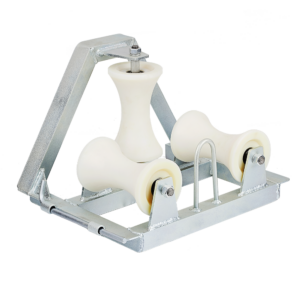
Understanding Electrical Hazards
In the realm of electric power construction, your safety hinges on recognizing and respecting the risks associated with electricity. Knowledge about the common hazards and the nature of electricity-related injuries is essential.
Identifying Common Hazards
Electrical hazards on a construction site generally stem from:
- Power lines: Both overhead and underground power lines present serious risks.
- Improper use of equipment: Tools that are damaged or not rated for the electrical requirements can cause accidents.
- Contact with live parts: Handling live wires or components can result in electrocution.
To keep yourself safe, always assume that all wires are live and potent sources of electrical danger. Follow site safety protocols rigorously and make sure you are familiar with the location of power lines and electrically powered equipment on your site.
Electrocution and Electrical Injuries
Electrocution is a critical concern in construction, potentially leading to severe injuries or fatalities. The nature of injuries can vary from:
- Burns: Contact with exposed wires or electrical arcs can cause severe burns.
- Cardiac arrest: Electricity can disturb the heart’s rhythm, leading to cardiac arrest.
- Muscle, nerve, and tissue damage: Electric current can damage your body’s muscle fibers and nerves.
Remember, using Personal Protective Equipment (PPE) and following lockout/tagout procedures are non-negotiable practices to prevent contact with live electrical components and ensure your safety.
Regulatory Compliance and Standards
Ensuring the safety of electric power construction projects hinges on adhering to specific regulations and standards. Knowing and following these guidelines is essential to maintaining a safe working environment.
OSHA and NEC Guidelines
The Occupational Safety and Health Administration (OSHA) provides regulations designed to safeguard you while working with or around electrical hazards. Compliance with OSHA standards minimizes risks such as electric shock, electrocutions, and fires. Key OSHA standards include:
- 29 CFR 1910 Subpart S: Relates specifically to electrical safety requirements that you must follow in the workplace.
- 29 CFR 1926 Subpart K: Addresses electrical safety standards in construction.
The National Electrical Code (NEC), formally known as NFPA 70, establishes the foundation for electrical safety in residential, commercial, and industrial occupancies. As you work on electrical power construction:
- Follow NEC standards for installation and construction practices to ensure that all electrical systems are safe and up to code.
- Keep up with NEC updates, as they are revised every three years to reflect the latest in safety practices and technologies.
Worker Safety Regulations
When it comes to your safety and the safety of your coworkers, various worker safety regulations implemented by OSHA must be strictly followed:
- Training: Receive proper training in electrical safety work practices.
- Personal Protective Equipment (PPE): Use appropriate PPE like gloves, helmets, and safety glasses.
- Lockout/Tagout (LOTO) Procedures: Apply these to ensure that hazardous electrical energies are properly isolated before any maintenance or repair.
Safety Equipment and Protective Gear
When you’re working on electrical power construction projects, ensuring your safety starts with the right gear. Personal Protective Equipment (PPE) is your first line of defense against potential hazards.
- Insulated Gloves: Crucial for protecting your hands, insulated gloves prevent electrical shocks and burns. Make sure they fit well and are suitable for the voltage you’ll be handling.
- Safety Glasses: Your eyes are vulnerable to sparks and debris. Wearing safety glasses shields them from harm.
- Hard Hats: Construction sites are filled with risks of falling objects. A hard hat will protect your head from such impacts.
- Helmets: Sometimes, a more robust helmet is necessary, especially when there’s a risk of electrical discharge.
Your PPE arsenal should be compliant with regulations, such as those set by the Occupational Safety and Health Administration (OSHA). This ensures that the equipment meets safety standards, giving you peace of mind while you work.
Remember to inspect your gear regularly for any signs of wear and tear. PPE should be in top condition to offer maximum protection. Stay up-to-date with your training on how to properly use and maintain this equipment. Your safety is paramount, and with the right protective gear, you’re already on the path to a safer work environment.
Safe Handling of Electrical Tools
Before using electrical tools on a construction site, familiarize yourself with the proper use of insulated tools and the maintenance required to keep these tools in good working order.
Proper Use of Insulated Tools
When working with electrical equipment, using insulated tools is crucial for your safety. Insulated tools are designed to protect you from accidental electrical shocks.
- Choose the Right Tool: Always use the tool specifically designed for the job you’re doing. For example, use pliers with insulated grips for wire manipulation.
- Inspect Before Use: Each time before using a tool, check the insulation for any damage or wear that could compromise its safety.
Maintenance and Care for Tools
Proper maintenance of your tools is as important as using the right tools for ensuring safety.
- Regular Inspections: Regularly examine your tools for signs of damage such as cracks, breaks, or wear on the insulation.
- Clean Storage: Store your tools in a dry, clean area to prevent any moisture from compromising the insulation.
- Immediate Repair or Replacement: If a tool shows signs of damage, remove it from use immediately until it can be properly repaired or replaced.
Risk Management and Prevention
Before diving into the specifics, remember that managing risks in electric power construction involves establishing robust safety protocols and conducting thorough risk assessments. Safety measures and foresight can significantly reduce the likelihood of accidents.
Electrical Safety Protocols
Your safety and the safety of your team should always come first. Start by implementing clearly defined electrical safety protocols. These include:
- Lockout/Tagout (LOTO) Procedures: Ensure that machines are properly shut off and cannot be started up again prior to the completion of maintenance or repair work.
- Personal Protective Equipment (PPE): Use appropriate PPE such as rubber insulating gloves, flame-resistant clothing, and insulated tools.
- Training: Regular safety training helps your team recognize hazards and understand the necessary precautions to take.
- Guarding: Employ physical barriers or insulation to prevent accidental contact with live electrical parts.
- Safe Work Practices: Follow a set of prescribed procedures for tasks such as de-energizing circuits, verifying absence of voltage, and grounding.
Conducting Risk Assessments
To prevent incidents before they occur, conducting risk assessments is critical. Here’s a streamlined approach:
- Identify Potential Hazards: Carefully review your work area for exposed wires, wet surfaces, and other electrical risks.
- Evaluate the Risks: Determine the severity and the probability of occurrences due to the identified hazards.
- Implement Control Measures: Decide on and put in place the necessary precautionary steps, from PPE to training.
- Review and Update: Continuously assess the effectiveness of these measures and make improvements where necessary.
Electrical System Safeguards
Ensuring your electrical systems in construction are secure involves implementing proper safeguards. Two fundamental components are grounding and circuit protection, along with strict lockout/tagout procedures.
Grounding and Circuit Protection
Your electrical system’s safety is significantly enhanced by effective grounding and the use of circuit breakers. Grounding directs any fault current safely into the earth, reducing the risk of shock or electrical fires. Ensure that all electrical panels are properly grounded and maintain this connection.
Circuit Breakers: These are crucial in protecting circuits from overloading and short-circuiting.
- Insulated Tools and Equipment: Always use insulated tools and ensure your equipment has appropriate insulation to minimize risks.
Lockout/Tagout Procedures
Lockout/tagout procedures are critical when performing maintenance or repairs, providing a physical means to indicate that the equipment should not be energized.
Steps for Lockout/Tagout:
- Notification: Inform all affected employees that a lockout/tagout procedure is about to be implemented.
- Shut Down: Turn off the equipment following the established protocol.
- Isolation: Ensure the equipment is isolated from any energy sources.
- Lockout/Tagout: Apply lockout devices to energy-isolating fixtures and attach appropriate tags.
- Verify Isolation: Before beginning work, verify that the equipment is properly isolated and de-energized.
Construction Site Safety Planning
Your construction site safety hinges on robust planning and preparedness. It’s vital that you dedicate time and resources to crafting a meticulous safety plan and ensuring all personnel are trained for emergency response.
Developing a Comprehensive Safety Plan
When developing a safety plan, your first step is to conduct a thorough risk assessment of the construction site. This will guide you in identifying potential electrical hazards. Here’s a quick rundown of what your safety plan should include:
- Clear identification of risks: List out all electrical hazards you might encounter.
- Safety procedures: Develop and document procedures to mitigate identified risks. This could include lockout/tagout protocols, proper use of personal protective equipment (PPE), and guidelines for tool inspections.
- Regular safety meetings: Schedule routine ‘toolbox talks’ to keep safety front of mind.
It’s crucial that your safety plan is accessible to all workers, so make sure it’s distributed to your team and discussed in detail. Keep the plan up to date with any changes in regulations or site-specific conditions.
Emergency Response and Training
A crucial aspect of safety planning is preparing for the worst-case scenario. Here’s what your emergency response training should encompass:
- Immediate actions: Outlining the steps to take in case of an electrical incident.
- First aid: Train your team in electrical safety-specific first aid.
- Evacuation routes: Ensure these are well-marked and known by all workers.
Electrical safety training is not a one-off event. To maintain high safety standards, ongoing training is essential. This includes:
- Onboarding: Introduce new workers to your site’s safety plan and procedures.
- Refresher courses: Provide regular training updates to veteran team members to keep their skills sharp.
- Operational Best Practices
When working in the construction industry, particularly with construction electricity, your safety and the safety of your team hinge on following rigorous operational best practices. Safety should always be your paramount concern, and adhering to these guidelines helps maintain a secure workplace.
Here are some essential safe working practices to consider:- Power Line Awareness:
- Before climbing a tree or a ladder, always identify and keep a safe distance from power lines.
- Maintain at least 10 feet from overhead power lines and assume they are live.
- Proper Tool Usage:
- Use tools that are approved by the Occupational Safety and Health Administration (OSHA) for added safety assurance.
- Inspect tools regularly for wear and damage.
- Equipment Handling:
- Employ non-conductive tools like fiberglass ladders when working near electrical sources.
- Fostering a Culture of Safety:
- Regularly attend and provide safety training.
- Encourage team discussions about HSE (Health, Safety, and Environment) protocols.
- Dealing with Electricity Directly:
- When necessary, ensure that power lines are de-energized and grounded before the commencement of work.
- Never directly touch or handle a power line or anything in contact with it.
- Power Line Awareness:


